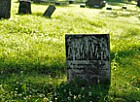
Fulton St. Cemetery
GRHC - June 23rd, 2010
The history of Grand Rapids' early burial plot.
Transcript
The burying ground for the early village of Grand Rapids was near the southwest corner of Cherry St. and Madison Avenue. When Fulton St. Cemetery was established in 1838, the graves were transferred there from the old location.
The original six acres of Fulton St. Cemetery contained sections 1, 2, 3, and 4, which stand in the center of the current grounds. They were purchased for $300 from Rev. James Ballard, who later served as principal for both the east-side Stone School and the west-side Union School. As the city grew, additions were made to the cemetery in 1862, 63, and the final one in 1864 completing the current twelve acres.
A little known section for still-born babies lies along the eastern edge of the cemetery. The earliest marked grave is that of Andrew Haldane, probably the younger brother of William Haldane, the father of Grand Rapids furniture. Andrew, who died in 1835, was one of those moved to Fulton St. from the early burying grounds. Another “transfer” was James Short, builder of the steamer Gov. Mason, who died in April of 1838 just before the opening of the new cemetery.
John Suttle, a landscape gardener from England, operated a large greenhouse and florist business at the NE corner of E. Fulton and Cemetery St. (now Eastern Ave.) and served as the first sexton of the cemetery. He platted the original six-acre tract, planted trees and flowers, and served the Cemetery Association faithfully for many years.
Full Details
| Title | Fulton St. Cemetery |
|---|---|
| Creator | GRHC |
| Keywords | Glance at the Past, history, Fulton St., cemetery, WYCE, Grand Rapids, Historical Commission, Podcast |
| Duration | 2:16 |
| Pubdate String | June 23rd, 2010 |

 facebook
facebook